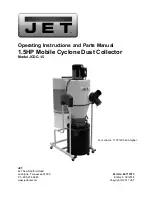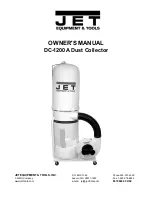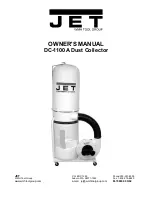
7
No adapter is available or should be used with this
tool. If the tool must be reconnected for use on a
different type of electric circuit, the reconnection
should be made by qualified service personnel;
and after reconnection, the tool should comply with
all local codes and ordinances.
Figure 2
6.2
Voltage conversion
To switch the incoming power leads for 230 volt
operation, follow the wiring diagram on the inside
cover of motor junction box. To access junction
box, remove filters and cover (part #1,
section
9.1.1
).
The plug on the end of the motor cord must be
replaced with a UL/CSA listed plug rated for 240V.
6.3
Extension cords
The use of extension cords is discouraged. Try to
place equipment within reach of the power source.
If an extension cord is necessary, make sure it is in
good condition and heavy enough to carry the
current your product will draw. An undersized cord
will cause a drop in line voltage resulting in loss of
power and overheating. Table 1 shows correct size
to use depending on cord length and nameplate
ampere rating. If in doubt, use the next heavier
gauge. The smaller the gauge number, the heavier
the cord.
Ampere
Rating
Volts
Total length of
cord in feet
More
Than
Not
More
Than
120
240
25
50
50
100
100
200
150
300
AWG
0
0
0
6
18
16
16 14
0
6 10
18
16
14 12
10 12
16
16
14 12
12 16
14
12
Not
Recommended
Extension Cord Recommendations
Table 1
7.0
Operation
Do not mix ferrous and non-
ferrous metal dust in the same dust collector.
Failure to comply will result in increased risk of
fire.
7.1
Control switch
Refer to Figure 3.
Pull out on switch (B) to start machine. Green
power indicator lamp (A) will illuminate.
Push switch in to stop. (Power indicator lamp will
turn off.)
The safety key (C) prevents unauthorized use of
the machine. Remove this key to deactivate the
switch; insert it to restart.
Figure 3
























